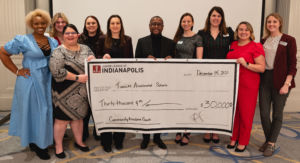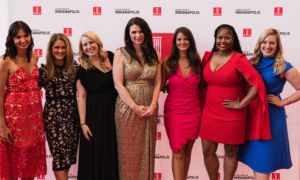
This whole thing started after I rewatched the movie “The Help.”
I had curled up with our two rescue dogs on a gray weekend afternoon, the weather just cold enough so that I had a good excuse to be lazy. But really the 2011 film adaptation of Kathryn Stockett’s best-selling book of the same name doesn’t require an excuse to watch — it’s a great story to enjoy no matter how many times you’ve seen it.
The movie chronicles the collaborative work of an aspiring writer and two Black maids who labor to tell stories of racism in 1960s Mississippi. Different period-appropriate elements are present — the women almost always wearing only skirts or dresses for example — and the Junior League plays a prominent role.
And that got me wondering: Is the Junior League still a thing?
What I learned surprised me, more than a little. And it reminded me of the value of being curious, not assuming things, and how important it is to appreciate the different ways people choose to become present, get involved, make a difference, and be changemakers.
People and projects over pearls
Stephanie Flittner is not opposed to pearls. She’s just weary of what some people think they represent. Flittner is president of the Junior League of Indianapolis (JLI), an organization celebrating its 100th anniversary this year. When people imagine the Junior League, they see stereotypical representations of the members and the organization, instead of what actually exists, Flittner said.

“The (idea) that makes me shudder is that ‘those women wear pearls.’ I have nothing against pearls. I love them, I wear them. But not every day,” Flittner said. “The perception that Junior League is a woman married to a wealthy man, and she does that nice volunteer work over lunch … that’s not what it is.”
Since its beginnings in Indianapolis in 1922, Flittner said the JLI has been doing philanthropic work across the metro area, starting with the very first project the then-new group took on a century ago.
“We actually started the Riley (Hospital for Children) occupational therapy unit, we started the entire thing, and we were present there until the 1940s,” Flittner said.
The Riley project was the first for the newly formed JLI. Ten women, the charter members, pledged to raise money and spend volunteer hours at the hospital. Charlotte Moxley, the organization’s first president, was quoted in an “Indianapolis Star” article explaining the goal of the JLI was to “inculcate … a feeling of civic obligation” in the women involved with the Junior League. Moxley not only advocated for organizations across the city through her work with the Junior League, she was also a founding member of the Orchard School.
That mission of civic obligation and involvement has remained constant, and the list of projects the JLI has funded or founded is impressive. The group brought the Susan G. Komen Race for the Cure 5K to Indianapolis in 1991, and about a decade before that, the JLI helped create The Apple Store at Conner Prairie. During World War II, JLI members sold war bonds and cooperated with other local service groups to support the U.S. war effort at home and overseas.

The goal, Flittner said, has always been to “find a need in the community and identify it” and to get the event or organization stable enough to operate on its own so that the JLI can turn its attention to another challenge that needs assistance. Through Holiday Mart, one of the group’s longest and largest fundraisers, and other efforts, JLI has donated through gifts and grants more than $4 million to community organizations just since 2000. And more than 150 different community groups have benefitted.
“What I would tell a woman who is thinking of joining, or wondering why to join the Junior League, is it’s a wonderful way to get exposed to the need that exists in Indianapolis,” Flitter said.
And the professional women who make up the vast majority of the organization’s membership look to other Junior Leaguers for support and understanding about what it means to be engaged at a high level at work, at home, and in the community. Flittner joined after law school, because she wanted leadership opportunities and to connect with other women who wanted to build friendships while building their community.
“I have like-minded friends, people I wouldn’t have met otherwise if it weren’t for the Junior League,” she said. “The development of, and the goal of developing women … anyone can find volunteer work satisfying, but I find that my heart feels good when I do good work with my friends.”
Is JLI an adult sorority?
Just a few minutes into a conversation with Kimberly Bugg and it becomes abundantly clear, this woman is effective and she knows how to have fun.

Bugg moved to Indianapolis from Ohio in 2014 and almost immediately wanted to find something that would remind her of the friendships she has and purpose she feels with her Delta Sigma Theta sorority sisters.
“It was something I wanted to do because I was looking for an opportunity to network with other professional women and have a broader net cast in terms of community service.”
Bugg, who holds an MBA in project management, said she understands why some people might have the impression of Junior League that they have. Even a decade ago when she joined, the JLI wasn’t what it is today.
“If I were on the outside looking into Junior League, before we had gotten to this standing where we are with diversity and inclusion, I probably would have thought very differently, I probably would have thought savior complex in a sense,” Bugg said.
But as a Black professional woman in Indianapolis who wanted to grow her network, she saw Junior League as an opportunity to help create the change she wanted to see in the world.
“I didn’t allow it to deter me, I thought it was in my power and up to me to initiate change. I probably could have counted the number of African Americans involved at that time. But it has so grown, and it shows how we have been intentional in our efforts,” she said. “Representation means something.”
And it’s not just racial and ethnic diversity and inclusivity the JLI has worked toward, but more women of different ages are joining, too.
“I’m so happy to see that our membership is now diverse with age. There’s still a lot of young women as well, I don’t think that’s ever going to fade out. But I’m so happy to see women in different stages of their lives joining,” Bugg said.
Bugg said some elements of JLI feel very familiar to women who have been involved in a sorority, but experience with Greek life is hardly essential.
For example, JLI utilizes something called a “provisional membership” that is essentially a trial period for would-be members, and includes dues fees and service hour requirements. A regular membership also includes fees and service hour expectations.
“A lot of our nomenclature is familiar in that respect to traditional sororities, but if you don’t have that experience, there is still a connection to women who have a commitment to service. We empower our members to grow and develop in leadership, and to take that back to their own personal and professional lives.”
The key word, Bugg said, is empowerment.

“That’s at the core for me. Junior League gives you an opportunity to grow as a person, in a variety of skillsets. The experience you gain through Junior League is applicable in other environments, personally and professionally. You have the opportunity, in this day and age, to engage in diversity of thought, to be proactive in what you want to do, to be of service to your community. There are so many ways to engage internally in the organization, externally with our partners — with Junior League you can really say the organization allows you to come in, learn about the history of the League, empower yourself and empower your community.
“We are turning over this 100 years, we have evolved so well. We are growing, learning how to be better and that’s exciting. I’m excited about what we have in store.”
So, what about me?
Well, I won’t be joining Junior League. Not because I don’t like what JLI does or who they are, but simply because my other volunteer boards eat all the free time I have.
Besides, for me, joining was never the goal.
I had questions and wanted answers and I got them — and came away much more knowledgeable about my adopted city and the people who make it a great place to call home. I got introduced to a group of smart, savvy women who gave me strong Tina Fey/Amy Pohler “Saturday Night Live” Weekend Update vibes about women getting stuff done, because they do. We do. And that’s enough.
Lisa Renze-Rhodes is a journalism coach, advocate and practitioner who believes a long walk with dogs is the answer to almost any question. Also Mother Teresa was right, just do good anyway. Connect with Lisa on Twitter and LinkedIn.
All of our content—including this article—is completely free. However, we’d love if you would please consider supporting our journalism with an Indy Maven membership.







